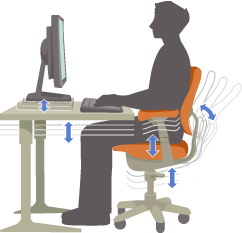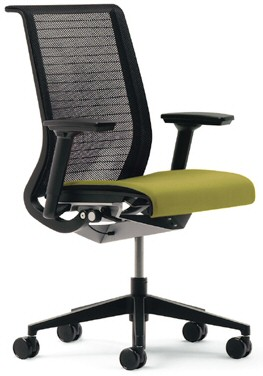Bias Lighting
I’ve talked about computer workstation ergonomics before, but one topic I didn’t address is lighting. We computer geeks like it dark. Really dark. Ideally, we’d be in a cave. A cave… with an internet connection.

The one thing that we can’t abide is direct overhead lighting. Every time the overhead light gets turned on in this room, I feel like a Gremlin shrieking Bright light! Bright light! Oh, how it burns!
But there is a rational basis for preferring a darkened room. The light setup in a lot of common computing environments causes glare on the screen:
If your room’s lit, as most are, by fittings hanging from the ceiling, you’ll be wanting to set up your monitor so that you don’t see reflections of the lights in it. The flat screens on many modern monitors (like the excellent Samsung I review here) help, because they reflect less of the room behind you. And anti-reflective screen coatings are getting better and better too. But lots of office workers still just can’t avoid seeing one or more ceiling fluoros reflected in their screen.
A good anti-reflective coating can reduce most such reflections to annoyance level only. But if you can see lights reflected in your screen, you can probably also directly see lights over the top of your monitor. Direct line of sight, or minimally darkened reflected line of sight, to light sources is going to give you glare problems.
Glare happens when there are small things in your field of vision that are much brighter than the general scene. Such small light sources can’t be handled well by your irises; your eyes’ pupil size is matched to the overall scene illumination, and so small light sources will appear really bright and draw lines on your retinas. The more of them there are, and the brighter they are, the more work your eyes end up doing and the sooner they’ll get tired.
While a darkened room is better for viewing most types of computer displays, it has risks of its own. It turns out that sitting in a dark room staring at a super bright white rectangle is… kind of bad for your eyes, too. It doesn’t help that most LCDs come from the factory with retina-scorching default brightness levels. To give you an idea of how crazy the defaults truly are, the three monitors I’m using right now have brightness set to 25/100. Ideally, your monitors shouldn’t be any brighter than a well-lit book. Be sure to crank that brightness level down to something reasonable.
You don’t want total darkness, what you want is some indirect lighting – specifically bias lighting. It helps your eyes compensate and adapt to bright displays.
“[Bias lighting] works because it provides enough ambient light in the viewing area that your pupils don’t have to dilate as far. This makes for less eyestrain when a flashbang gets thrown your way or a bolt of lightning streams across the screen,” he told Ars. “Because the display is no longer the only object emitting light in the room, colors and black levels appear richer than they would in a totally black environment. Bias lighting is key in maintaining a reference quality picture and reducing eye-strain.”
Bias lighting is the happy intersection of indirect lighting and light compensation. It reduces eye strain and produces a better, more comfortable overall computing display experience.

The good news is that it’s trivially easy to set up a bias lighting configuration these days due to the proliferation of inexpensive and bright LEDs. You can build yourself a bias light with a clamp and a fluorescent bulb, or with some nifty IKEA LED strips and double-sided foam tape. It really is that simple: just strap some lights to the back of your monitors.
I’m partial to the IKEA Dioder and Ledberg technique myself; I currently have an array of Ledbergs behind my monitors. But if you don’t fancy any minor DIY work, there are a wide array of inexpensive self-adhesive LED strips out there – which also have the benefit of being completely USB powered, and thus can power up and down with your monitor or TV.

Of course, lighting conditions are a personal preference, and I’d never pitch bias lighting as a magic bullet. But there is science behind it, it’s cheap and easy to try, and I wish more people who regularly work in front of a computer knew about bias lighting. If nothing else, I hope this post gets people to turn their LCD monitors down from factory brightness level infinity to something a tad more gentle on the old Mark I Eyeball.







